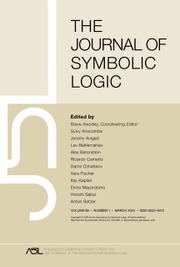Article contents
Orthomodularity is not elementary1
Published online by Cambridge University Press: 12 March 2014
Extract
In this note it is shown that the property of orthomodularity of the lattice of orthoclosed subspaces of a pre-Hilbert space  is not determined by any first-order properties of the relation ⊥ of orthogonality between vectors in
is not determined by any first-order properties of the relation ⊥ of orthogonality between vectors in  . Implications for the study of quantum logic are discussed at the end of the paper.
. Implications for the study of quantum logic are discussed at the end of the paper.
The key to this result is the following:
If is a separable Hilbert space, and
is a separable Hilbert space, and is an infinite-dimensional pre-Hilbert subspace of
is an infinite-dimensional pre-Hilbert subspace of , then (
, then ( , ⊥) and (
, ⊥) and ( , ⊥) are elementarily equivalent in the first-order languageL2of a single binary relation.
, ⊥) are elementarily equivalent in the first-order languageL2of a single binary relation.
Choosing  to be a pre-Hilbert space whose lattice of orthoclosed subspaces is not orthomodular, we obtain our desired conclusion. In this regard we may note the demonstration by Amemiya and Araki [1] that orthomodularity of the lattice of orthoclosed subspaces is necessary and sufficient for a pre-Hilbert space to be metrically complete, and hence be a Hilbert space. Metric completeness being a notoriously nonelementary property, our result is only to be expected (note also the parallel with the elementary L2-equivalence of the natural order (Q, <) of the rationals and its metric completion to the reals (R, <)).
to be a pre-Hilbert space whose lattice of orthoclosed subspaces is not orthomodular, we obtain our desired conclusion. In this regard we may note the demonstration by Amemiya and Araki [1] that orthomodularity of the lattice of orthoclosed subspaces is necessary and sufficient for a pre-Hilbert space to be metrically complete, and hence be a Hilbert space. Metric completeness being a notoriously nonelementary property, our result is only to be expected (note also the parallel with the elementary L2-equivalence of the natural order (Q, <) of the rationals and its metric completion to the reals (R, <)).
To derive (1), something stronger is proved, viz. that ( , ⊥) is an elementary substructure of (
, ⊥) is an elementary substructure of ( , ⊥).
, ⊥).
Information
- Type
- Research Article
- Information
- Copyright
- Copyright © Association for Symbolic Logic 1984
Footnotes
The work reported in this paper was done in late 1975. At the time it presented itself not so much as a contribution to quantum logic as a counterexample to a possible line of enquiry. Recently I explained the results to Bas van Fraassen, who encouraged me to make them available for publication.
References
REFERENCES
- 39
- Cited by

